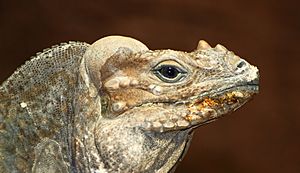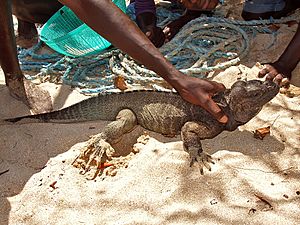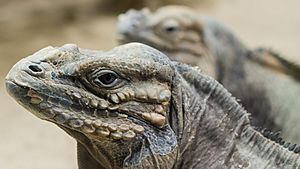Rhinoceros iguana facts for kids
Quick facts for kids Rhinoceros iguana |
|
|---|---|
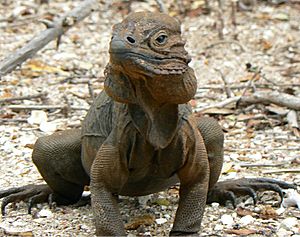 |
|
| A male rhinoceros iguana, Pedernales, Dominican Republic | |
| Conservation status | |
| Scientific classification | |
| Genus: |
Cyclura
|
| Species: |
cornuta
|
| Subspecies | |
|
|
The rhinoceros iguana (Cyclura cornuta) is a large lizard found only on the Caribbean island of Hispaniola. This island is shared by Haiti and the Dominican Republic. These iguanas are an endangered species. They can grow from about 60 to 136 centimeters long. Their skin can be grey, dark green, or even brown. They are named for the bony bumps on their snout, which look like a rhinoceros horn. Rhinoceros iguanas often live near Ricord's iguanas. They are the only two types of rock iguanas that live together in the same areas.
Contents
About the Rhinoceros Iguana Name
The rhinoceros iguana belongs to a group of lizards called Cyclura. Its scientific name, cornuta, comes from a Latin word meaning "horned." This refers to the horn-like bumps on the males' snouts. A scientist named Pierre Joseph Bonnaterre first identified this species in 1789.
There are two main types of rhinoceros iguanas. The most common one, C. c. cornuta, lives on Hispaniola. The other type, the extinct Navassa Island iguana (C. c. onchiopsis), used to live on Navassa Island but is now gone.
Body and Appearance
Rhinoceros iguanas are large lizards with strong legs and a thick tail. They have a row of pointed scales that run from their neck to their tail. Their color is usually a plain gray or brown. Adult iguanas weigh between 4.5 and 9 kilograms. Like all reptiles, they are cold-blooded. This means they need to use outside heat sources, like the sun, to warm up their bodies. They move around to find the best sunny spots to get warm.
The most special thing about these iguanas is the bony, horn-like bumps on their snouts. Male iguanas also have a fatty pad on the back of their heads and a large flap of skin under their chin called a dewlap. Males are usually bigger than females. They also have larger crests on their backs and bigger "horns." Males have special pores on their thighs that release chemicals called pheromones. These chemicals help them communicate with other iguanas.
Where Rhinoceros Iguanas Live
Rhinoceros iguanas live in different places across Hispaniola, in both Haiti and the Dominican Republic. Their populations are strong only on Isla Beata and in Jaragua National Park. Some groups also live in southeastern Haiti and its nearby islands, including the salty lake Étang Saumâtre. In the Dominican Republic, they live near the very salty Lake Enriquillo and its island, Isla Cabritos. In Haiti, their numbers are even more at risk because of trees being cut down, hunting, and land being cleared by people.
These iguanas live in different types of dry, rocky areas. They prefer places with little rain and few trees or bushes. They love barren landscapes with large rocks and rocky spots where they can sunbathe. They also need cracks and sheltered areas to hide from predators. If they feel threatened by humans, birds, or wild dogs and cats, they will quickly hide in the rocks.
Rhinoceros iguanas have learned to adapt to changes in their environment. Even though they used to live near coastlines, human activity and new predators have made them move further inland. In 2008, one iguana was seen on Limbe Island in northern Haiti. This showed that they live in areas not previously known. Sadly, iguanas caught on Limbe Island are sometimes eaten by local people.
Rhinoceros iguanas also used to live on Navassa Island. However, the type of iguana that lived there is now extinct.
Rhinoceros Iguana Behavior
Rhinoceros iguanas are usually calm and gentle. Like many lizards, they communicate by "head-bobbing." Males often nod their heads to show they are dominant or to claim an area. This can be a warning to others to stay away, or a way to show females they want to mate. Sometimes, both wild and pet iguanas will head-bob at humans as a warning or a greeting. Females mostly head-bob to stop males from bothering them. Female-to-female head-bobbing is not common.
Many rhinoceros iguanas, especially those raised by humans, are very friendly. Some even seem to enjoy being petted like a dog or cat. However, how friendly an iguana is can change from day to day or season to season. They are very sensitive to their surroundings. A friendly iguana might suddenly want to be left alone for no clear reason.
Even though they prefer to run away when in danger, they will bite and hit with their strong tails if they feel trapped. Their long claws can also cause scratches, even if the iguana is being friendly. Some owners wear thick gloves when handling them.
What Rhinoceros Iguanas Eat
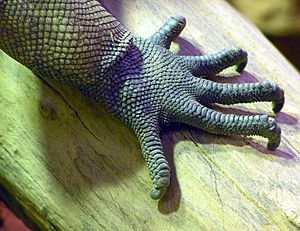
Rhinoceros iguanas mostly eat plants. They munch on leaves, flowers, berries, and fruits from different plants. A study in 2000 found that seeds that pass through an iguana's stomach grow faster. This helps the seeds sprout before the short rainy season ends. Rhinoceros iguanas also help spread these seeds to new places, especially when females move to nesting spots. As the largest plant-eaters on their island, they are very important for keeping the balance between the climate and plants. Sometimes, rhinoceros iguanas will also eat small lizards, snakes, and insects.
Rhinoceros Iguana Life Cycle and Reproduction
Male rhinoceros iguanas can start having babies when they are four to five years old. Females can start when they are two to three years old. Male iguanas protect their own areas. The strongest males have the biggest territories. Mating happens at the start of the rainy season, usually from May to June, and lasts for about two to three weeks.
Females lay between 2 and 34 eggs, with about 17 eggs on average. They lay their eggs within 40 days. Females stay and guard their nests for several days after laying the eggs. The eggs hatch after about 85 days.
Unlike many other iguanas, male and female rhinoceros iguanas look quite similar. Both have dewlaps (skin flaps under their chin) and develop horns. In many other animals with horns, like deer or rhinoceros beetles, only the males have them. Rhinoceros iguanas also don't differ much in size between males and females. This might be because female iguanas fight each other for the best nesting spots, which are rare on their island. They use their horns to fight, just like males fight for mates. This kind of female-female fighting has also been seen in other island iguanas, like the marine iguana.
Protecting Rhinoceros Iguanas
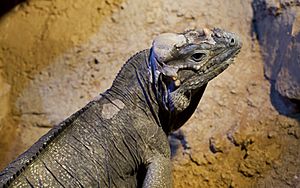
Even though many rhinoceros iguanas are kept in zoos and by people, only about 10,000 to 16,000 are left in the wild. From 1974 to 1994, a successful program at the ZooDom in the Dominican Republic helped breed these iguanas. About 100 babies hatched each year. Some of these young iguanas were released into protected areas. This helped them grow bigger and stronger before facing predators like snakes, wild cats, and dogs. This program stopped in 1995.
Trading these iguanas internationally is controlled by a treaty called CITES. This helps protect endangered species. Many human activities threaten the rhinoceros iguana. These include illegal logging (cutting down trees), competition for food from farm animals (cows, pigs, goats), predators like mongooses and wild cats and dogs eating young iguanas, mining for limestone, hunting them for food, pollution, and wildfires.
Rhinoceros Iguanas in Zoos
Rhinoceros iguanas are common in zoos and private collections. In 2007, there were many in zoos across the United States. There are also many in European and Asian zoos, and as pets. Because so many are bred in captivity, there is less need to take them from the wild.
Gallery
See also
 In Spanish: Iguana cornuda para niños
In Spanish: Iguana cornuda para niños



